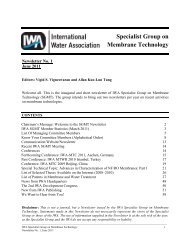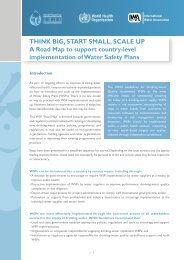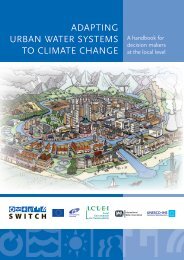Sanitation 21 planning framework - IWA
Sanitation 21 planning framework - IWA
Sanitation 21 planning framework - IWA
- No tags were found...
You also want an ePaper? Increase the reach of your titles
YUMPU automatically turns print PDFs into web optimized ePapers that Google loves.
<strong>Sanitation</strong> <strong>21</strong>order to plan for the general improvement ofsanitation for all parts of the city and society, arange of options was proposed, based on theexisting physical and financial constraints (Table8). Using this strategic approach, it could beseen that sewerage coverage was only likely toincrease marginally in the near future, as existingcatchment sewers were in-filled to make a denserpipe network. Extensions outside the existingcatchments are unlikely for 20 years.Solar City, City of Linz, AustriaThe city of Linz is the capital of the province ofUpper Austria, has about 200.000 inhabitants andis situated around the river Danube. In the secondhalf of the 1990s the city council decided to builda new ecological housing area (low energy type,solar energy) in the South of the city comprised ofabout 1400 flats and a school. The constructionstarted in 1999 and the first flats were ready forhousing in 2003. Whereas about 90% of thishousing area was connected to the nearby sanitationsystem (a sewer connecting to a recently renovatedcentral wastewater treatment plant for the Cityof Linz), there was a wish to furnish a small partof this new housing area (about 100 flats) withadditional ecological features. After some discussionthe decision was taken that innovative options for itswastewater management should be considered.Considered options and assessmentOriginally it was planned to furnish the entire newhousing area with a non-conventional wastewatermanagement system. About 14 different alternatives,including both conventional and non-conventionalones, were studied. However, the cost assessmenthas shown that the cheapest option would be toconnect the housing area to the existing centralisedtreatment plant (as an existing sewer passes byclose to the new housing area) and therefore it waseconomically not justifiable to construct an alterativesystem. However, for various reasons it was decidedthat a smaller area (only 88 flats and a school) wouldcomprise the pilot project for a urine separatingsystem.Decision making processFor the pilot area it was decided to implement anoption which was comprised of the separation ofthe wastewater in its constituent’s parts, urine,brownwater and greywater, and to furnish around100 flats with urine sorting toilets of the company‘Roediger’. The main reason for this decision wasfirstly the possibility to close the nutrient cycle andsecondly the possibility to treat only urine, if micropollutantswill get more attention in the future (i.e. itis assumed that reduction of micro-pollutants fromBreakdown of existing sanitation coveragein Greater Kampala, UgandaFig4100 %All households93.8 %Have own toilet (private/shared)6.2 %Do not have own toilet69.8 %Latrines24 %Flush toilet69.8 2.5 %Public Latrines toilet1.0 %Neighbours’ toilet2.7 %Garden, bag, drain69.6 %Pit latrine0.1 %Bucket0.1 %Other6.4%Sewer17.5 %Septic tank5.6 %To NWSCsewer0.8 %To other sewerSource: <strong>Sanitation</strong> strategy andMaster Plan for Kampala City.Better Consult, Mott MacDonaldand M&E Associates– 31 –
















